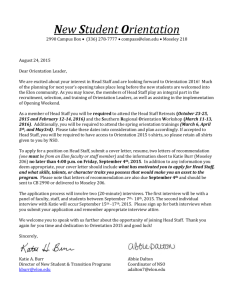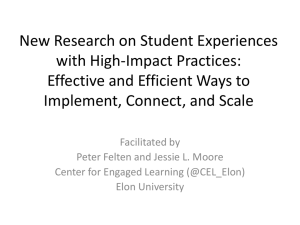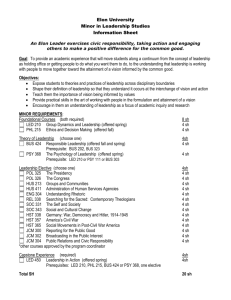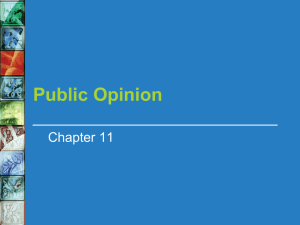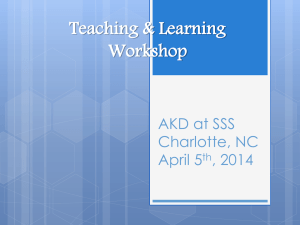Data - Elon University
advertisement
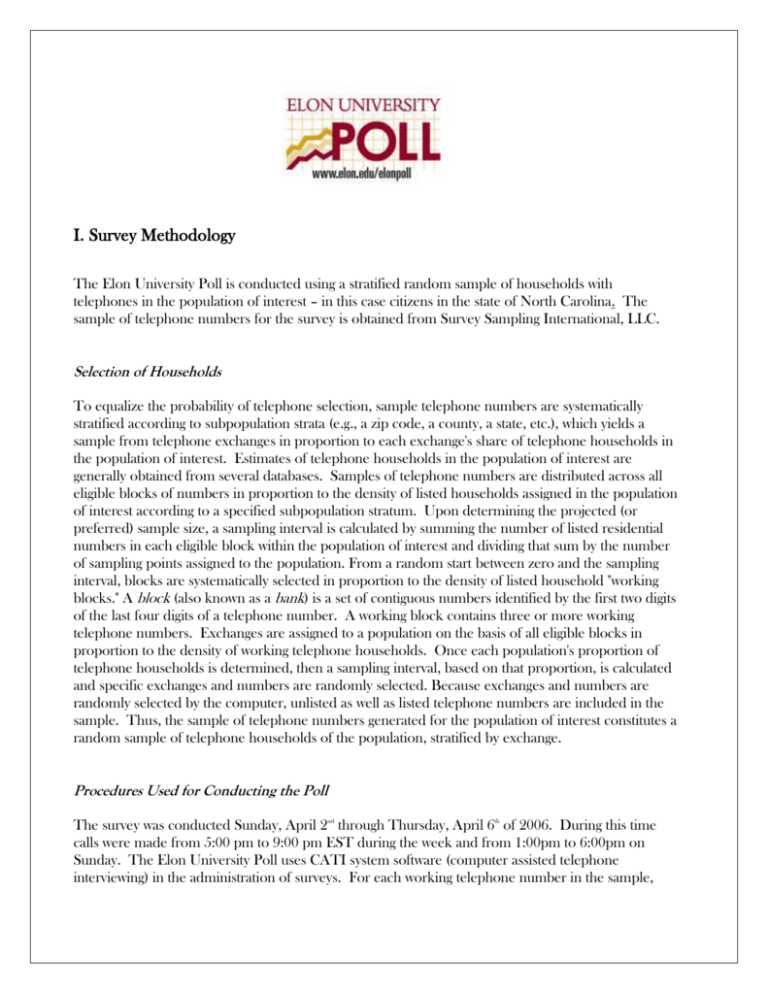
I. Survey Methodology The Elon University Poll is conducted using a stratified random sample of households with telephones in the population of interest – in this case citizens in the state of North Carolina. The sample of telephone numbers for the survey is obtained from Survey Sampling International, LLC. Selection of Households To equalize the probability of telephone selection, sample telephone numbers are systematically stratified according to subpopulation strata (e.g., a zip code, a county, a state, etc.), which yields a sample from telephone exchanges in proportion to each exchange's share of telephone households in the population of interest. Estimates of telephone households in the population of interest are generally obtained from several databases. Samples of telephone numbers are distributed across all eligible blocks of numbers in proportion to the density of listed households assigned in the population of interest according to a specified subpopulation stratum. Upon determining the projected (or preferred) sample size, a sampling interval is calculated by summing the number of listed residential numbers in each eligible block within the population of interest and dividing that sum by the number of sampling points assigned to the population. From a random start between zero and the sampling interval, blocks are systematically selected in proportion to the density of listed household "working blocks." A block (also known as a bank) is a set of contiguous numbers identified by the first two digits of the last four digits of a telephone number. A working block contains three or more working telephone numbers. Exchanges are assigned to a population on the basis of all eligible blocks in proportion to the density of working telephone households. Once each population's proportion of telephone households is determined, then a sampling interval, based on that proportion, is calculated and specific exchanges and numbers are randomly selected. Because exchanges and numbers are randomly selected by the computer, unlisted as well as listed telephone numbers are included in the sample. Thus, the sample of telephone numbers generated for the population of interest constitutes a random sample of telephone households of the population, stratified by exchange. Procedures Used for Conducting the Poll The survey was conducted Sunday, April 2nd through Thursday, April 6th of 2006. During this time calls were made from 5:00 pm to 9:00 pm EST during the week and from 1:00pm to 6:00pm on Sunday. The Elon University Poll uses CATI system software (computer assisted telephone interviewing) in the administration of surveys. For each working telephone number in the sample, several attempts were made to reach the household. Only individuals in households 18 years or older were interviewed; those reached at business or work numbers were not interviewed. Interviews were completed with 677 adults from households in North Carolina. For a sample size of 677, there is a 95 percent probability that our survey results are within plus or minus 3.8 percent (the margin of error) of the actual population distribution for any given question. For sub-samples, the margin of error is higher depending on the size of the subsample. When we use a subsample, we identify these results as being from a subsample and provide the total number of respondents and margin of error for that subsample. In reporting our results, we note any use of a subsample where applicable. No subsamples are represented in these results. Questions and Question Order The Elon University Poll provides the questions as worded and the order in which these questions are administered (to respondents). Conspicuous in reviewing some questions is the “bracketed” information. Information contained within brackets ( [ ] ) denotes response options as provided in the question; this bracketed information is rotated per question to ensure that respondents do not receive a set order of response options presented to them, which also maintains question construction integrity by avoiding respondent acquiescence based on question composition. Some response options appearing in tables include a “missing” category. Sometimes responses are considered “missing” when, for a variety of reasons, respondents are not qualified to respond to a particular question or set of questions (a “skip” maneuver or “screening” technique is employed), or simply terminate the interview upon completing an acceptable proportion of the survey instrument (with the acceptable proportion completed being based on polling protocol). Some questions used a probe maneuver to determine a respondent’s intensity of perspective. Probe techniques used in this questionnaire mainly consist of asking a respondent if their response is more intense than initially provided. For example, upon indicating whether s/he is satisfied or dissatisfied, we asked the respondent “would you say you are very ”. This technique is employed in some questions as opposed to specifying the full range of choices in the question. Though specifying the full range of options in questions is a commonly accepted practice in survey research, we sometimes prefer that the respondent determine whether their perspective is stronger or more intense for which the probe technique used. Another method for acquiring information from respondents is to ask an “openended” question. The open-ended question is a question for which no response options are provided, i.e., it is entirely up to the respondent to provide the response information. The Elon University Poll The Elon University Poll is conducted under the auspices of the Center for Public Opinion Polling (Hunter Bacot, Director), which is a constituent part of the Institute for Politics and Public Affairs (George Taylor, Director); both these organizations are housed in the department of political science at Elon University. These academic units are part of Elon College, the College of Arts and Sciences at Elon University, which is under the direction of Dr. Steven House (Dean). The Elon University administration, led by Dr. Leo Lambert, President of the university, fully support the Elon University Poll as part of its service commitment to state, regional, and national constituents. The Elon University Poll is directed by Dr. Hunter Bacot, a professor in the department of political science; he is assisted by Monique Lyle, the Elon University Polling Fellow for 2005-06. The survey is administered by Elon University students as part of the University’s commitment to experiential learning where “students learn through doing.” II. Survey Instrument and Percentage Distributions by Question Interviews were completed with 677 adults from households in North Carolina. For a sample size of 677, there is a 95 percent probability that our survey results are within plus or minus 3.8 percent (the margin of error) of the actual population distribution for any given question. Data are weighted to reflect the adult population in terms of gender. As you may know, local school districts decide how much money to spend on each student based on available funds, which results in different levels of spending per student in NC school districts. So, when funding levels aren't equal across districts, should the state give money to ensure that all school districts spend about the same amount on each student? Percent No, state should not give money 14.1 Yes, state should give money 82.6 Don't Know 3.2 Refused .1 Total (677) 100.0 Do you think the state of NC should be involved in determining how local school districts manage their affairs? Percent No, state should not be involved 31.6 Yes, state should be involved 62.2 Don't Know Refused Total (677) 5.9 .3 100.0 Do you feel that the state should take over schools based on their performance? Percent No, state should not be involved Yes, state should be involved Don't Know Refused Total (677) 46.2 43.9 9.6 .3 100.0 Do you think state courts should be involved in determining how local school districts manage their affairs? Percent No, courts should not be involved Yes, courts should be involved 55.7 36.5 Don't Know 7.8 Total (677) 100.0 Have the recent gas prices affected you or others in your household financially? Percent No, have not affected us 16.3 Yes, have affected us 83.1 Don't Know .6 Total (677) 100.0 Gas Prices Affecting People Financially 100 90 83.1 78.7 80 70 Percent 60 Elon University Poll October 2005 [Total=539, ±4.3%] Elon University Poll April 2006 [Total=677, ±3.8%] 50 40 30 21.3 20 16.3 10 0 No, have not affected us Yes, have affected us Do you think there's anything that the governor can reasonably do to reduce gasoline prices, or do you think gas prices have risen because of factors beyond the governor's control? Percent Governor can do something about it 45.4 Beyond Governor's control 48.6 Don't Know 5.9 Total (677) 100.0 Can Governor do Something to Reduce Gas Prices 100 90 80 70 Percent 60 50 48.2 45.4 46.3 Elon University Poll October 2005 [Total=539, ±4.3%] Elon University Poll April 2006 [Total=677, ±3.8%] 48.6 40 30 20 10 5.2 5.9 0 Governor Can do Something Beyond Governor's Control Don't Know Do you think there's anything that the NC legislature can reasonably do to reduce gasoline prices, or do you think gas prices have risen because of factors beyond the legislature's control? Percent NC Legislature can do something about it Beyond NC Legislature's control 50.5 41.6 Don't Know 7.9 Total (677) 100.0 Can Legislature Do Something to Reduce Gas Prices 100 90 80 70 Percent 60 50.1 Elon University Poll October 2005 [Total=539, ±4.3%] 50.5 50 Elon University Poll April 2006 [Total=677, ±3.8%] 44.9 41.6 40 30 20 7.9 10 4.4 0 NC Legislature Can do Something Beyond Legislature's Control Don't Know

